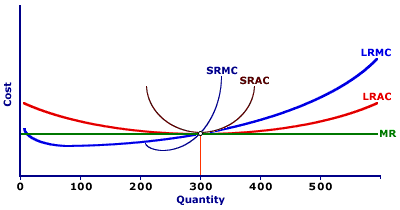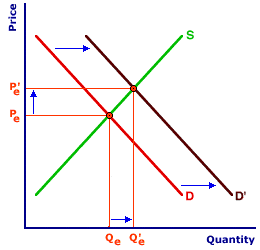
|
|
GENERAL STRIKE: A strike by a majority of the workers in key industries throughout a country in a particular region of the country. This type of strike is different in both magnitude and intent than that of a strike against a specific firm or industry. In particular, a general strike involves virtually every union regardless of industry or occupation. In addition, the intent of a general strike is to bring the economy to a standstill as a means of forcing major structural changes in the economy or society. Such a strike has been effectively used from time to time, but because it does shut down the economy and imposes hardships on almost everyone.
Visit the GLOSS*arama
|
|


|

|
                           PERFECT COMPETITION, LONG-RUN PRODUCTION ANALYSIS: In the long run, a perfectly competitive firm adjusts plant size, or the quantity of capital, to maximize long-run profit. In addition, the entry and exit of firms into and out of a perfectly competitive market guarantees that each perfectly competitive firm earns nothing more or less than a normal profit. As a perfectly competitive industry reacts to changes in demand, it traces out positive, negative, or horizontal long-run supply curve due to increasing, decreasing, or constant cost. Perfect competition is a market structure characterized by a large number of small firms producing identical products with perfect resource mobility and perfect knowledge. These conditions mean that individual firms maximize profit and achieve efficiency and that the entire industry achieves long-run efficiency through the entry and exit of firms into and out of the industry.Long-Run Adjustment| Long-Run Adjustment |  |
The two adjustments undertaken by a perfectly competitive industry in the pursuit of long-run equilibrium are:- Firm Adjustment: Each firm in the perfectly competitive industry adjustments short-run production and long-run plant size to achieve profit maximization. This adjustment entails producing the quantity that equates price (and marginal revenue',500,400)">marginal revenue) to short run marginal cost for a given plant size as well as selecting the plant size that equates price (and marginal revenue) to long-run marginal cost.
- Industry Adjustment: Firms enter and exit a perfectly competitive industry in response to economic profit and loss. If firms in the industry earn above-normal profit, or receive economic profit, then other firms are induced to enter. If firms in the industry receive below-normal profit, or incur economic loss, then existing firms are induced to exit. The entry and exit of firms causes the market price to change, which eliminates economic profit and loss, and leads to exactly normal profit.
The combination of firm and industry adjustment results in a multivariable equilibrium condition in which the price (which is also average and marginal revenue) is equal to marginal cost and average cost (both short run and long run). This long-run equilibrium illustrated in the exhibit above is achieved at the minimum efficient scale',500,400)">minimum efficient scale of the long-run average cost curve. | P = AR = MR = MC = LRMC = ATC = LRAC |
With price, marginal revenue, and average revenue (P = MR = AR) equal to marginal cost (MC and LRMC), each firm maximizes profit and has no reason to adjust its quantity of output or plant size. With price and average revenue (P = AR) equal to average cost (ATC and LRAC), each firm in the industry is earning only a normal profit. Economic profit is zero and there are is economic loss.Long-Run Industry Supply CurveThe long-run adjustment undertaken by a perfect competitive industry in response to demand shocks can result in increasing, decreasing, and constant costs, which then trace out long-run industry supply curves that are positively-sloped, negative-sloped, or horizontal, respectively.The path taken by an industry depends on underlying changes in resource prices and production cost. If the expansion of an industry causes higher resource prices and production cost, then the result is an increasing-cost industry. If expansion causes lower resource prices and production cost, then the result is a decreasing-cost industry. If expansion has no affect on resource prices and production cost, then the result is a constant-cost industry. | The Zucchini Market |  |
This exhibit illustrates the hypothetical Shady Valley zucchini market, which is shocked by an increase in demand. The original market equilibrium, with the supply curve S and the demand curve D, is equilibrium price Pe and equilibrium quantity Qe. The increase in demand causes the equilibrium price of zucchinis increases to Pe' and the equilibrium quantity rises to Qe'. The higher price and larger quantity is achieved as each existing firm in the industry responds to the demand shock.However, the higher price leads to above-normal economic profit for existing firms. And with freedom of entry and exit, economic profit attracts kumquat, cucumber, and carrot producers into this zucchini industry. An increase in the number of firms in the zucchini industry then causes the market supply curve to shift. How far this curve shifts and where it intersects the new demand curve, D', determines if the zucchini market is an increasing-cost, decreasing-cost, of constant-cost industry. The three alternatives are: - Increasing-Cost Industry: An industry with a positively-sloped long-run industry supply curve that results because expansion of the industry causes higher production cost and resource prices. An increasing-cost industry occurs because the entry of new firms, prompted by an increase in demand, causes the long-run average supply curve of each firm to shift upward, which increases the minimum efficient scale of production. Click the [Increasing-Cost] button to illustrate.
- Decreasing-Cost Industry: An industry with a negatively-sloped long-run industry supply curve that results because expansion of the industry causes lower production cost and resource prices. A decreasing-cost industry occurs because the entry of new firms, prompted by an increase in demand, causes the long-run average cost curve of each firm to shift downward, which decreases the minimum efficient scale of production. Click the [Decreasing-Cost] button to illustrate.
- Constant-Cost Industry: An industry with a horizontal long-run industry supply curve that results because expansion of the industry causes no change in production cost or resource prices. A constant-cost industry occurs because the entry of new firms, prompted by an increase in demand, does not affect the long-run average cost curve of individual firms, which means the minimum efficient scale of production does not change. Click the [Constant-Cost] button to illustrate.

Recommended Citation:PERFECT COMPETITION, LONG-RUN PRODUCTION ANALYSIS, AmosWEB Encyclonomic WEB*pedia, http://www.AmosWEB.com, AmosWEB LLC, 2000-2025. [Accessed: June 30, 2025].
Check Out These Related Terms... | | | | | | |
Or For A Little Background... | | | | | | | | | |
And For Further Study... | | | | | |
Search Again?
Back to the WEB*pedia
|



|

|
|
The penny is the only coin minted by the U.S. government in which the "face" on the head looks to the right. All others face left.
|

|
|
"I learned about the strength you can get from a close family life. I learned to keep going, even in bad times. I learned not to despair, even when my world was falling apart. I learned that there are no free lunches. And I learned the value of hard work. " -- Lee Iacocca
|

|
IIP
Index of Industrial Production
|

|
|
Tell us what you think about AmosWEB. Like what you see? Have suggestions for improvements? Let us know. Click the User Feedback link.
User Feedback
|


|


